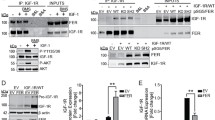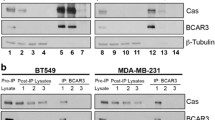Abstract
In order to study the effect of estrogens and antiestrogens on the adhesive properties of human breast cancer cells, the attachment on endothelial cells (EC), on subendothelial extracellular matrix (ECM) and on ECM components (collagen I and IV, laminin, fibronectin) of estrogen-dependent (MCF-7, ZR75-1) and estrogen-independent (BT-20) breast cancer cell lines was investigated. The cells were grown under conditions of controlled exposure to estrogen [17β-estradiol (E2)] and/or antiestrogens [tamoxifen (Tam) or 4-hydroxytamoxifen (OH-Tam]. Treatment by E2 enhanced the ability of ZR75-1 cells to adhere to the various substrates, which contrasts with the observed absence of effects with the BT-20 cells. Similarly, Tarn or OH-Tam induced a reduction of the adhesion of ZR75-1 tumor cell, but not of BT-20 cells. This effect was reversed by competing concentrations of E2. The effects on MCF-7 cell adhesion were similar to those described for ZR75-1 cells, but could not be reproducibly observed. Adhesion assays carried out with ZR75-1 cells grown in the absence or presence of phenol red, a pH indicator which behaves as a weak estrogen, led to a similar pattern of cell attachment. Conditioned media harvested from E2-or Tamtreated ZR75-1 cells failed to induce any effect on adhesion of other ZR75-1 cells grown in E2-deprived medium, suggesting that secretory activities are not required for the control of cell adhesiveness. The results suggest that estrogens and antiestrogens can control the adhesive behavior of breast tumor cells through their hormone responsive structures possibly by regulating expression of cell adhesion proteins and/or their cell surface receptors.
Similar content being viewed by others
References
Abecassis, J., Millon-Collard, R., Klein-Soyer, C., Nicora, F., Fricker, J.-P., Beretz, A., Eber, M., Muller, D., andCazenave, J.-P., 1987, Adhesion of human breast cancer cell line MCF-7 to human vascular endothelial cells in culture. Enhancement by activated platelets.International Journal of Cancer,40, 525–531.
Albini, A., Graf, J., Kitten, G. T., Kleinmann, H. K., Martin, G. R., Veillette, A., andLippman, M. E., 1986, 17β-Estradiol regulates and v-Ha-ras transfection constitutively enhances MCF-7 breast cancer cell interactions with basement membrane.Proceedings of the National Academy of Sciences of the U.S.A.,83, 8182–8186.
Bardon, S., Vignon, F., Montcourrier, P., andRochefort, H., 1987, Steroid receptor-mediated cytotoxicity of an antiestrogen and an antiprogestin in breast cancer cells.Cancer Research,47, 1441–1448.
Berthois, Y., Katzenellenbogen, J. A., andKatzenellenbogen, B. S., 1986, Phenol red in tissue culture media is a weak estrogen: implications concerning the study of estrogen-responsive cells in culture.Cell Biology,83, 2496–2500.
Butler, W. B., Kirkland, W. L., Gargala, T. L., Goran, N., Kelsey, W. H., andBerlinski, P. J., 1983, Steroid stimulation of plasminogen activator production in a human breast cancer cell line (MCF-7).Cancer Research,43, 1637–1641.
Conower, W. J., 1980,Practical Non-parametric Statistics (New York: Wiley), p. 299.
Coezy, E., Borgna, J.L., andRochefort, H., 1982, Tamoxifen and metabolites in MCF-7 cells: correlation between binding to estrogen receptor and inhibition of cell growth.Cancer Research,42, 317–323.
Dickson, R. B., andLippman, M. E., 1987, Estrogenic regulation of growth and polypeptide growth factor secretion in human breast carcinoma.Endocrine Reviews,8, 29–43.
Franceschi, R. T., Linson, C. J., Peter, T. C., andRomano, P. R., 1987, Regulation of cellular adhesion and fibronectin synthesis by 1α,25-dihydroxyvitamin D3.Journal of Biological Chemistry,262, 4165–4171.
Furcht, L. T., Mosher, D. F., Wendelschafer-Crabb, G., Woodbridge, P. A., andFoidart, J. M., 1979, Dexamethasone-induced accumulation of a fibronectin and collagen extracellular matrix in transformed human cells.Nature (London),277, 393–395.
Grover, A., andAdamson, E. D., 1985, Roles of extravellular matrix components in differentiating teratocarcinoma cells.Journal of Biological Chemistry,260, 12252–12258.
Ignotz, R. A., Endo, T., andMassague, J., 1987, Regulation of fibronectin and type I collagen mRNA levels by transforming growth factor-beta.Journal of Biological Chemistry,262, 6443–6446.
Ignotz, R. A., andMassague, J., 1987, Cell adhesion protein receptors as targets for transforming growth factor-beta action.Cell,51, 189–197.
Kao, R. T., andStern, R., 1986, Collagenases in human breast carcinoma cell lines.Cancer Research,46, 1349–1354.
Kato, S., andDe Luca, L. M., 1987, Retinoic acid modulates attachment of mouse fibroblasts to laminin substrates.Experimental Cell Research,173, 450–462.
Klein-Soyer, C., Stierle, A., Bouderbala, B., andCazenave, J.-P., 1984, Effects of an extract of human brain containing growth factor activity on the proliferation of human vascular endothelial cells in primary culture.Biology of the Cell,52, 9–20.
Liotta, L. A., 1984, Tumor invasion and metastases: role of basement membranes.American Journal of Pathology,117, 337–348.
Liotta, L. A., Rao, C. N., andWewer, U. M., 1986, Biochemical interactions of tumor cells with the basement membrane.Annual Review of Biochemistry,55, 1037–1057.
Morisset, M., Capony, F., andRochefort, H., 1986, The 52-kDa estrogen-induced protein secreted by MCF-7 cells is a lysosomal acidic protease.Biochemical and Biophysical Research Communications,138, 102–109.
Osborne, C. K., Hobbs, K., andClark, G. M., 1985, Effect of estrogens and antiestrogens on growth of human breast cancer cells in athymic nude mice.Cancer Research,45, 584–590.
Osborne, C. K., Hobbs, K., andTrent, J. M., 1987, Biological differences among MCF-7 human breast cancer cell lines from different laboratories.Breast Cancer Research and Treatment,9, 111–121.
Pourreau-Schneider, N., Martin, P. M., Charpin, C., Jacquemier, J., Saez, S., andNandi, S., 1984, How culture conditions modulate the morphofunctional differentiation of the human estradiol-sensitive mammary cell line (MCF-7).Journal of Steroid Biochemistry,20, 407–415.
Sapino, A., Pietribiasi, F., Bussolati, G., andMarchisio, P. C., 1986, Estrogen- and tamoxifen-induced rearrangement of cytoskeletal and adhesion structures in breast cancer MCF-7 cells.Cancer Research,46, 2526–2531.
Shafie, S. M., andLiotta, L. A., 1980, Formation of metastasis by human breast carcinoma cells (MCF-7) in nude mice.Cancer Letters,11, 81–87.
Sutherland, R. L., Reddel, R. R., andGreen, M. D., 1983, Effects of oestrogens on cell proliferation and cell cycle kinetics. A hypothesis on the cell cycle effects of antioestrogens.European Journal of Cancer and Clinical Oncology,19, 307–318.
Terranova, V. P., Hujanen, E. S., andMartin, G. R., 1986, Basement membrane and the invasive activity of metastatic tumor cells.Journal of the National Cancer Institute,77, 311–316.
Thorne, H. J., Jose, D. G., Zhang, H.-Y., Dempsey, P. J., andWhitehead, R. H., 1987, Epidermal growth factor stimulates the synthesis of cell-attachment proteins in the human breast cancer cell line PMC42.International Journal of Cancer,40, 207–212.
Vic, P., Vignon, F., Deroco, D., andRochefort, H., 1982, Effect of estradiol on the ultrastructure of the MCF-7 human breast cancer cells in culture.Cancer Research,42, 667–673.
Vignon, F., Bouton, M.-M., andRochefort, H., 1987, Antiestrogens inhibit the mitogenic effect of growth factors on breast cancer cells in the total absence of estrogens.Biochemical and Biophysical Research Communications,146, 1502–1508.
Westley, B. R., andMay, F. E.B., 1987, Oestrogen regulates cathepsin D mRNA levels in oestrogen responsive human breast cancer cells.Nucleic Acids Research,15, 3773–3786.
Author information
Authors and Affiliations
Rights and permissions
About this article
Cite this article
Millon, R., Nicora, F., Muller, D. et al. Modulation of human breast cancer cell adhesion by estrogens and antiestrogens. Clin Exp Metast 7, 405–415 (1989). https://doi.org/10.1007/BF01753661
Received:
Accepted:
Issue Date:
DOI: https://doi.org/10.1007/BF01753661




